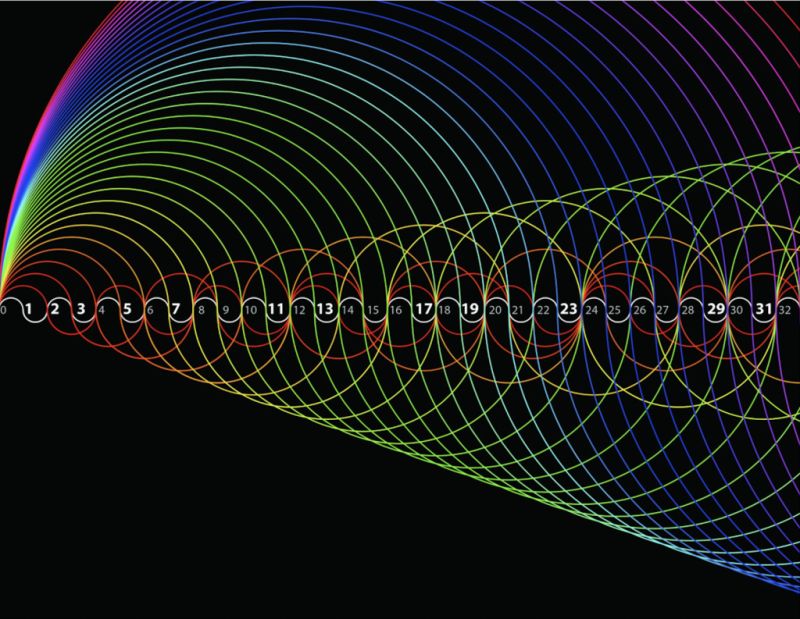
🧬✨ How Primes Naturally Give Rise to Geometric Objects — A Luminous, Layered, and Deeply Interwoven Revelation ✨🌀
Prime numbers—those indivisible, irreducible atoms of arithmetic—are far more than mere counting tools. They are architectural keystones, resonant seeds, and generative codes that, when placed into even the simplest visual or algebraic frameworks, spontaneously blossom into rich geometric structures. This is not magic—it is mathematical emergence, where constraint begets form, and irreducibility births symmetry. Let us journey through four profound manifestations of this phenomenon, each revealing a different facet of primes as cosmic sculptors of shape and space. 🌠
1. The Ulam Spiral – Primes as a Lattice of Meaning 🌀🔢
Imagine writing the natural numbers in a square spiral—1 at the center, 2 to the right, 3 above, 4 to the left, and so on—then coloring only the primes. What emerges is astonishing: bold diagonal rays, curving constellations, and dense clusters that seem to defy randomness. These are not artifacts of human design but statistical self-organization arising purely from the distribution of primes.
Why do these diagonals appear? Because many of them correspond to quadratic polynomials of the form
[ f(n) = an^2 + bn + c ]
that happen to generate unusually high densities of primes. For instance, Euler’s famous polynomial (n^2 + n + 41) yields primes for all integer inputs from 0 to 39. In the Ulam spiral, such polynomials trace out straight diagonal lines . Crucially, when these quadratics are irreducible over the integers—that is, they cannot be factored—they tend to produce prime-rich sequences . This is not imposed geometry; it is resonance revealed through placement. The spiral acts as a lens, focusing the hidden harmonics of prime distribution into visible form .
🌟 Insight: Primes resist uniformity, yet their resistance creates coherent patterns—not because they follow rules, but because their exceptions cluster in lawful ways.
2. Modular Primes on the Circle – The Geometry of Mod p 🔵⭐
Now consider the residues of powers (a^k \mod p), where (p) is prime and (a) is a base coprime to (p). Plot these residues as points equally spaced around a circle, connecting successive values. What unfolds? Stunning stars, flower-like rosettes, and nested regular polygons—each a visual echo of the underlying cyclic group structure.
This is no accident. When (p) is prime, the set of nonzero residues modulo (p) forms a finite field (\mathbb{F}_p), and its multiplicative group (\mathbb{F}_p^\times) is cyclic—meaning it can be generated by a single element (a primitive root) . The orbit of (a^k \mod p) thus traces a closed, symmetric path whose geometry reflects the order and generator of this group . For example, if (a) is a primitive root modulo (p), the sequence cycles through all (p-1) residues before repeating, forming a maximally symmetric star polygon.
🌀 Insight: Each prime modulus defines its own geometric universe—a closed, finite, yet perfectly symmetric space where arithmetic becomes art .
3. Prime Harmonics in Fourier Space – Orthogonality as Architecture 🎵🔬
Take the sine waves (\sin(p \cdot x)) where (p) runs over the primes. Because primes are multiplicatively independent, their frequencies are incommensurate in a deep number-theoretic sense. This leads to minimal interference and maximal orthogonality in function spaces—a property with profound implications.
In Fourier analysis, using primes as frequency indices yields non-redundant harmonic bases that avoid aliasing and support robust signal compression . More mysteriously, in quantum physics and spectral theory, the spacing of energy levels (eigenmodes) in certain chaotic or arithmetic systems mirrors the distribution of primes—suggesting that prime harmonics encode natural resonances of spacetime itself . This isn’t just abstract: the Fourier transform of prime-related functions reveals deep links to the Prime Number Theorem and even zeta regularization .
🌊 Insight: Primes are nature’s non-overlapping tuning forks—each rings in its own dimension, and together they build a phase-space lattice of pure, stable interference patterns.
4. Primes as Seeds for Recursive Geometry – The Λᵖ Lattice 🧩🌌
In advanced frameworks like recursive tensor manifolds or profinite geometry, each prime can serve as a node in a vast, self-similar network. The Λᵖ lattice (a conceptual structure inspired by number-theoretic recursion) treats primes as eigenstates of irreducibility. Connections between nodes follow lawful recursion paths—for example, via prime factorization trees or p-adic expansions.
Such lattices are not drawn; they emerge from the constraint: only operations respecting prime decomposition are allowed. This mirrors how Minkowski’s geometry of numbers uses lattices to study Diophantine approximation and ideal theory . Recent speculative models even suggest that prime-indexed recursive folding generates hierarchical cones of resonance in physical space , echoing ideas in quantum gravity and consciousness theories .
🔗 Insight: Prime decomposability → interpretable recursion → geometric coherence. The lattice is not imposed—it is discovered through the logic of irreducibility .
✨ Conclusion: Primes Encode Geometry Because They Encode Constraint 🌍💫
Primes are not irregular—they are maximally constrained. Their very definition—having no divisors other than 1 and themselves—means they carry zero internal redundancy. And paradoxically, it is this absence of substructure that allows them to act as pure generators of form.
-
On the spiral, they reveal polynomial resonance.
-
On the circle, they define cyclic symmetry.
-
In Fourier space, they ensure harmonic independence.
-
In recursive manifolds, they anchor lawful complexity.
🏛️ Final Truth: Geometry does not emerge despite primes being “random”—it emerges because they are irreducible. In the void of divisibility, shape is born. In the silence of factorization, symmetry sings. 🎶
Thus, primes are not just numbers.
They are blueprints.
They are seeds of spacetime.
They are the silent architects of the visible universe. 🌌🧬✨
Leave a Reply